Identification of Geodiversity and Geosite Assessment around Geohazard Area of Suoh Aspiring Geopark in West Lampung, Sumatra, Indonesia
Abstract
1. Introduction
2. Materials and Methods
3. Results
4. Discussion
5. Conclusions
Author Contributions
Funding
Data Availability Statement
Acknowledgments
Conflicts of Interest
References
- Metcalfe, I. Tectonic Evolution of Sundaland. Bull. Geol. Soc. Malays. 2017, 63, 27–60. [Google Scholar] [CrossRef]
- Williams, H.; McBirney, A.R. Volcanology. In Volcanology; Jones & Bartlett Learning: Burlington, MA, USA, 1980. [Google Scholar]
- Iqbal, M.; Juliarka, B.R. Analisis Kerapatan Kelurusan (Lineament Density) Di Lapangan Panasbumi Suoh-Sekincau, Lampung. J. Sci. Appl. Technol. 2019, 3, 31–67. [Google Scholar] [CrossRef]
- Sonter, L.J.; Ali, S.H.; Watson, J.E.M. Mining and Biodiversity: Key Issues and Research Needs in Conservation Science. Proc. R. Soc. B Biol. Sci. 2018, 285, 1892. [Google Scholar] [CrossRef] [PubMed]
- Kementerian ESDM. Guidelines for Determining Geological Heritage (Geoheritage) Regulation No 1 of the Minister of Energy and Mineral Resources of the Republic of Indonesia. 2020. Available online: https://jdih.esdm.go.id/storage/document/Permen%20ESDM%20Nomor%201%20Tahun%202020-ocr.pdf (accessed on 10 November 2022).
- Herrera-Franco, G.; Montalván-Burbano, N.; Carrión-Mero, P.; Jaya-Montalvo, M.; Gurumendi-Noriega, M. Worldwide Research on Geoparks through Bibliometric Analysis. Sustainability 2021, 13, 1175. [Google Scholar] [CrossRef]
- Wibowo, R.C.; Sarkowi, M.; Setiawan, A.F.; Yudamson, A.; Kurniawan, M.; Arifianto, I. Flash Flood Hazard Areas Assessment in Bandar Negeri Suoh (BNS) Region Using an Index Based Approaches and Analytical Hierarchy Process. J. Phys. Conf. Ser. 2020, 1434, 012006. [Google Scholar] [CrossRef]
- Newsome, D.; Dowling, R. The scope and nature of geotourism. In Geotourism; Dowling, R., Newsome, D., Eds.; Routledge: London, UK, 2005; pp. 3–25. [Google Scholar]
- La Fua, J. Manajemen Pemanfaatan Sumber Daya Alam Di Indonesia Untuk Mendukung Pembangunan Berkelanjutan Melalui Pendekatan Ekonomi Hijau. Shautut Tarb. 2015, 21, 57–76. [Google Scholar]
- Henley, D.; Schulte Nordholt, H.G.C. History and Seismology in the Ring of Fire: Punctuating the Indonesian Past. In Environment, Trade and Society in Southeast Asia; Brill: Leiden, The Netherlands, 2015. [Google Scholar] [CrossRef]
- Farsani, N.T.; Coelho, C.O.; Costa, C.M.; Amrikazemi, A. Geo-knowledge management and geoconservation via ge-oparks and geotourism. Geoheritage 2014, 6, 185–192. [Google Scholar] [CrossRef]
- Brilha, J. Inventory and quantitative assessment of geosites and geodiversity sites: A review. Geoheritage 2016, 8, 119–134. [Google Scholar] [CrossRef]
- Ansori, C.; Setiawan, N.I.; Warmada, I.W.; Yogaswara, H. Identification of Geodiversity and Evaluation of Geosites to Determine Geopark Themes of the Karangsambung-Karangbolong National Geopark, Kebumen, Indonesia. Int. J. Geoherit. Park. 2022, 10, 1–15. [Google Scholar] [CrossRef]
- Migoń, P.; Pijet-Migoń, E. Natural Disasters, Geotourism, and Geo-Interpretation. Geoheritage 2019, 11, 629–640. [Google Scholar] [CrossRef]
- Çetiner, Z.S.; Ertekin, C.; Yiğitbaş, E. Evaluating Scientific Value of Geodiversity for Natural Protected Sites: The Biga Pen-insula, Northwestern Turkey. Geoheritage 2017, 10, 49–65. [Google Scholar] [CrossRef]
- Sieh, K.; Natawidjaja, D. Neotectonics of the Sumatran Fault, Indonesia. J. Geophys. Res. Solid Earth 2000, 105, 28295–28326. [Google Scholar] [CrossRef]
- Hidayatika, A.; Utami, P.; Suharno, S.; Amukti, R. Analysis of Thermal Manifestation in Suoh West Lampung Indonesia. In Proceedings of the World Geothermal Congress, Melbourne, Australia, 19–25 April 2015. [Google Scholar]
- Geological Survey Center of Indonesia. Technical Standards for Inventory of Geological Diversity and Identification of Geological Geritage; Indonesian Geological Agency: Bandung, Indonesia, 2017; p. 11. [Google Scholar]
- Gobbett, D.J.; Hutchinson, C.S. Geology of the Malay Peninsula; Ed. Wiley-Interscience. 1973. J. Geogr. (Chigaku Zasshi) 1973, 82, 219–220. [Google Scholar] [CrossRef]
- Iqbal, P.; Muslim, D.; Zakaria, Z.; Permana, H.; Jaya Syahbana, A.; Aji Satriyo, N.; Yunarto, Y.; Jakah, J.; Khoirullah, N. Tropical Volcanic Residual Soil. Prog. Volcanol. 2022, 3, 63–83. [Google Scholar] [CrossRef]
- Hurukawa, N.; Wulandari, B.R.; Kasahara, M. Earthquake History of the Sumatran Fault, Indonesia, since 1892, Derived from Relocation of Large Earthquakes. Bull. Seismol. Soc. Am. 2014, 104, 1750–1762. [Google Scholar] [CrossRef]
- Natawidjaja, D.H. Updating Active Fault Maps and Sliprates along the Sumatran Fault Zone, Indonesia. In Proceedings of the IOP Conference Series: Earth and Environmental Science, Bandung, Indonesia, 18–19 October 2017; IOP Publishing: Bristol, UK, 2018; Volume 118, p. 012001. [Google Scholar] [CrossRef]
- Rera, G.F.; Pratama, H.B.; Saptadji, N.M. Approach for Pre-Feasibility Study of Medium Enthalpy Geothermal Field, Case Study: Danau Ranau, Indonesia. In Proceedings of the IOP Conference Series: Earth and Environmental Science, Bandung, Indonesia, 10–13 August 2020; IOP Publishing: Bristol, UK, 2021; Volume 732, p. 012021. [Google Scholar] [CrossRef]
- USGS. Available online: https://earthquake.usgs.gov/ (accessed on 31 August 2022).
- Natawidjaja, D.H.; Bradley, K.; Daryono, M.R.; Aribowo, S.; Herrin, J. Late Quaternary Eruption of the Ranau Caldera and New Geological Slip Rates of the Sumatran Fault Zone in Southern Sumatra, Indonesia. Geosci. Lett. 2017, 4, 21. [Google Scholar] [CrossRef]
- Iqbal, P.; Muslim, D.; Zakaria, Z.; Permana, H.; Syahbana, A.J.; Yunarto, J. Geotechnical Characteristics of Volcanic Red Clay Soil Related to Geoengineering Problem in Sekincau, Sumatra, Indonesia. Int. J. Adv. Sci. Technol. 2020, 29, 3166–3173. [Google Scholar]
- Iqbal, P.; Muslim, D.; Zakaria, Z.; Permana, H.; Satriyo, N.A.; Syahbana, A.J.; Yunarto; Khoirullah, N.; Asykarullah, A.W. Swelling Potential of Volcanic Residual Soils in Sumatra (Indonesia) in Relation to Environmental Issues. Environ. Socio-Econ. Stud. 2020, 8, 4. [Google Scholar] [CrossRef]
- Bogie, I.; Mackenzie, K.M. The Application of a Volcanic Facies Model to an Andesitic Stratovolcano Hosted Geothermal System at Wayang Windu, Java, Indonesia. In Proceedings of the 20th NZ Geothermal Workshop; University of Auckland: Auckland, New Zealand, 1998; pp. 265–276. [Google Scholar]
- Aribowo, S. The Geometry of Pull-Apart Basins in the Southern Part of Sumatran Strike-Slip Fault Zone. In Proceedings of the IOP Conference Series: Earth and Environmental Science, Bandung, Indonesia, 18–19 October 2017; IOP Publishing: Bristol, UK, 2018; Volume 118, p. 012002. [Google Scholar] [CrossRef]
- Barber, A.J.; Crow, M.J. An Evaluation of Plate Tectonic Models for the Development of Sumatra. Gondwana Res. 2003, 6, 1–28. [Google Scholar] [CrossRef]
- Barber, A.J.; Crow, M.J.; Milsom, J. (Eds.) Sumatra: Geology, Resources and Tectonic Evolution (References); Geological Society of London: London, UK, 2005; Volume 21. [Google Scholar]
- Bellier, O.; Bellon, H.; Sébrier, M.; Maury, R.C. K-Ar Age of the Ranau Tuffs: Implications for the Ranau Caldera Emplacement and Slip-Partitioning in Sumatra (Indonesia). Tectonophysics 1999, 312, 347–359. [Google Scholar] [CrossRef]
- Bellier, O.; Sébrier, M. Relationship between Tectonism and Volcanism along the Great Sumatran Fault Zone Deduced by Spot Image Analyses. Tectonophysics 1994, 233, 215–231. [Google Scholar] [CrossRef]
- Idianto, O.; Rera, G.F.; Wardoyo, G.K.; Pratama, H.B.; Hamdani, M.R. Updated Conceptual Model and Resource Assessment Using Numerical Reservoir Simulation of Danau Ranau Geothermal Field Indonesia. In Proceedings of the IOP Conference Series: Earth and Environmental Science, Bandung, Indonesia, 10–13 August 2020; IOP Publishing: Bristol, UK, 2021; Volume 732, p. 012027. [Google Scholar] [CrossRef]
- Indrayati, I.; Lestari, F.; Kadafi, I.O. Kajian Pengembangan Kelembagaan & Pembiayaan Geopark Di Indonesia. 2021. Available online: http://repository.iti.ac.id/handle/123456789/821 (accessed on 10 September 2022).
- Direktorat Panas Bumi. Potensi Panas Bumi Indonesia Jilid 1. Direktorat Jenderal Energi Baru, Terbarukan dan Konservasi Energi, Kementerian Energi dan Sumber Daya Mineral, Indonesia. 2017. Available online: https://ebtke.esdm.go.id/post/2017/09/25/1751/buku.potensi.panas.bumi.2017 (accessed on 18 September 2022). (In Indonesian).
- Soehaimi, A.; Muslim, D.; Kamawan, I.; Negara, R.S. Microzonation of the Liwa City on the Great Sumatera Active Fault and Giant Ranau Volcanic Complex in South Sumatera, Indonesia. In Engineering Geology for Society and Territory-Volume 5: Urban Geology, Sustainable Planning and Landscape Exploitation; Springer: Berlin, Germany, 2015. [Google Scholar] [CrossRef]
- Golfinopoulos, V.; Papadopoulou, P.; Koumoutsou, E.; Zouros, N.; Fassoulas, C.; Zelilidis, A.; Iliopoulos, G. Quantitative Assessment of the Geosites of Chelmos-Vouraikos UNESCO Global Geopark (Greece). Geoscientifics 2022, 12, 63. [Google Scholar] [CrossRef]
- Massonnet, D.; Feigl, K.L. Radar Interferometry, and Its Application to Changes in the Earth’s Surface. Rev. Geophys. 1998, 36, 441–500. [Google Scholar] [CrossRef]
- García-Cortés, A.; Vegas, J.; Carcavilla, L.; Diaz-Martinez, E. Conceptual Base and Methodology of the Spanish Inventory of Sites of Geological Interest (Ielig); Instituto Geológico y Minero de España: Madrid, Spain, 2019; p. 102. [Google Scholar]
- Muslim, D.; Haerani, E.; Muslim, F.N.; Muslim, G.O. Toward the safe live-able built environment around Ciletuh-Palabuhanratu Geopark Area in Sukabumi Regency, Indonesia. In Proceedings of the IOP Conference Series: Earth and Environmental Science, Bandung, Indonesia, 18–19 October 2017; IOP Publishing: Bristol, UK, 2019; Volume 248, p. 012036. [Google Scholar] [CrossRef]
- Matsumoto, M.; Sasaki, T.; Muslim, D. A study on the level of disaster awareness and preparedness between Indonesian and Japanese students. J. Jpn. Soc. Civ. Eng. Ser. F6 (Saf. Probl.) 2018, 74, 53–62. [Google Scholar] [CrossRef]
- Haerani, E.; Muslim, F.N.; Muslim, G.O.; Muslim, D. Human Resources in the Urban Environment of Citatah Mining Area, West Bandung Regency, Indonesia. In Proceedings of the IOP Conference Series: Earth and Environmental Science, Bandung, Indonesia, 25–26 October 2018; IOP Publishing: Bristol, UK, 2019; Volume 248, p. 012042. [Google Scholar] [CrossRef]
- Dicky, M.; Haerani, E.; Shibayama, M.; Ueshima, M.; Kagawa, N.; Hirnawan, F. Disaster Awareness Education for Children in Schools Around Geological Hazard Prone Areas in Indonesia. In Engineering Geology for Society and Territory-Volume 6; Springer Cham: Berlin, Germany, 2015; pp. 107–111. [Google Scholar] [CrossRef]
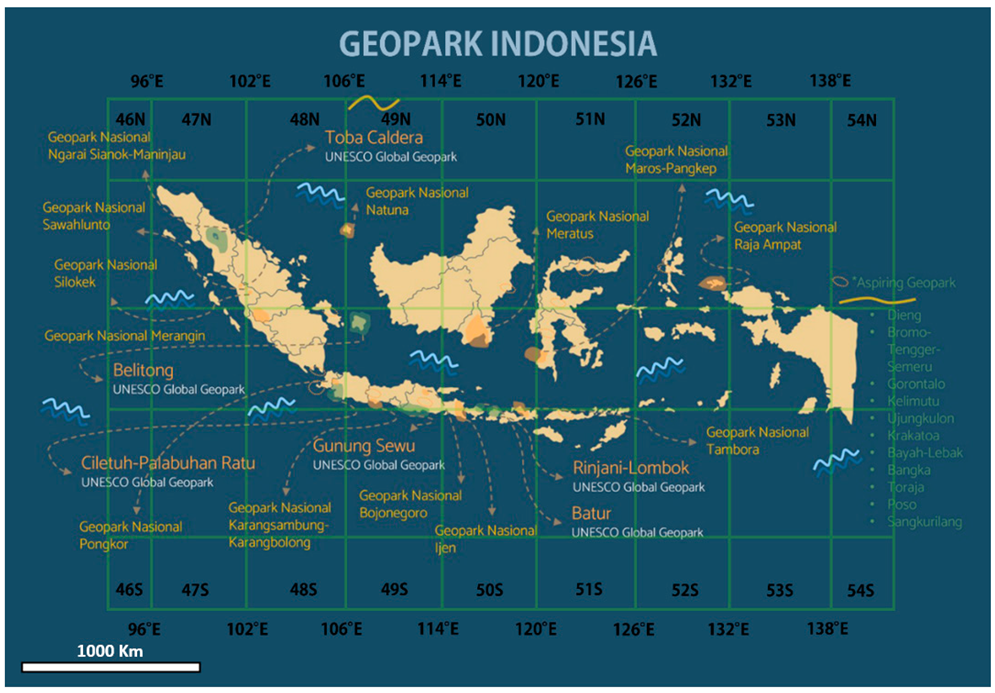

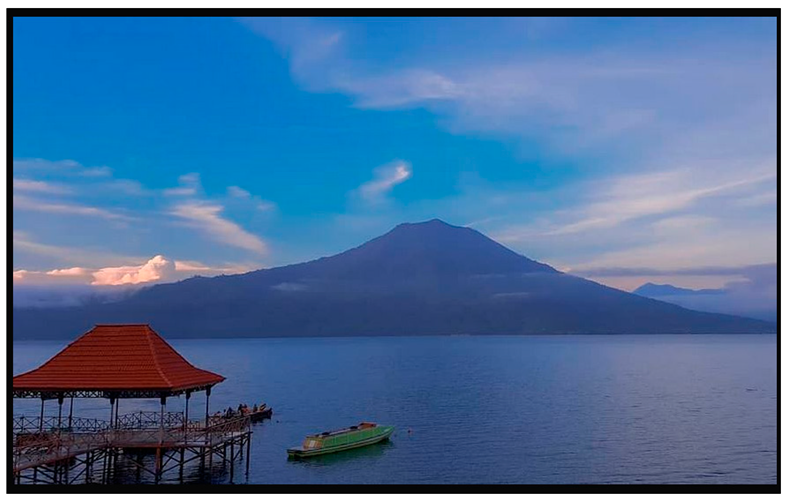

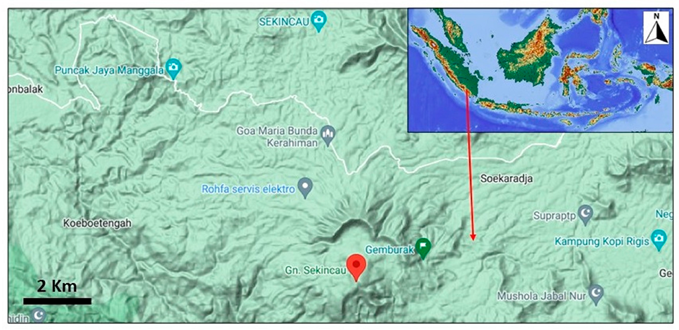
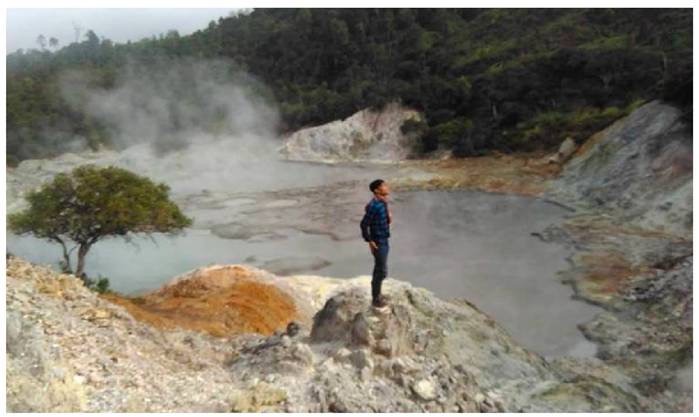
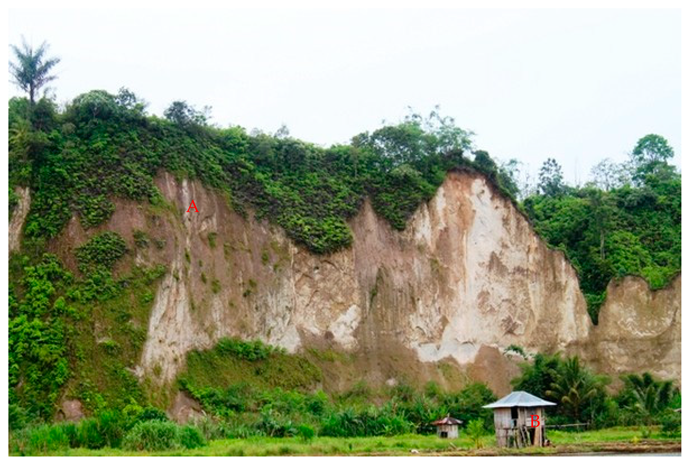
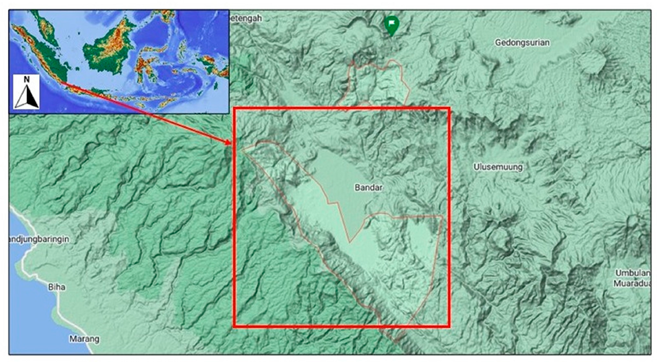
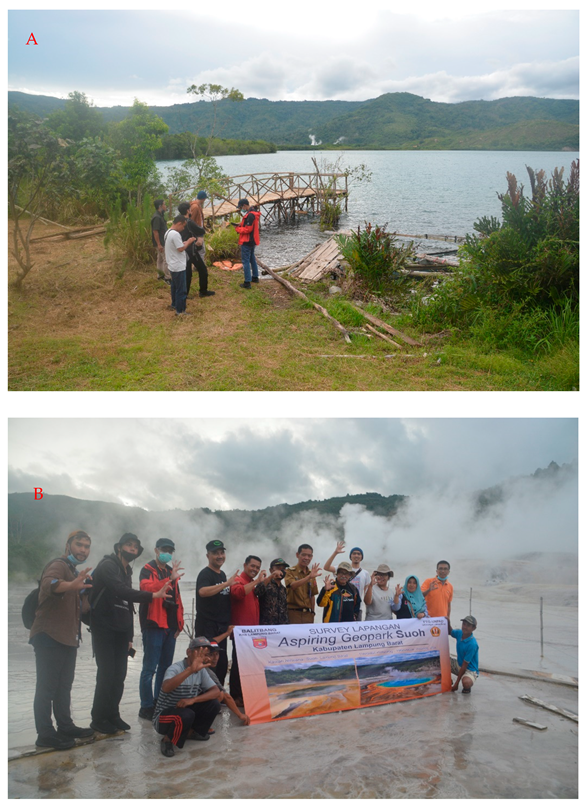
| No | Geosite | Long. (E) | Lat. (S) | Scientific Value | Education Value | Tourism Value | Degradation Risk Value | Final Value |
|---|---|---|---|---|---|---|---|---|
| 1 | Asam Lake | 104.278166° | −5.238389° | 102.28 | 76.25 | 91.25 | 76.25 | 346.03 |
| 2 | Lebar Lake | 104.271500° | −5.247194° | 77.77 | 82.5 | 76.25 | 52.5 | 289.02 |
| 3 | Minyak lake | 104.265333° | −5.247167° | 75.27 | 82.5 | 70 | 38.75 | 266.52 |
| 4 | Nirwana Crater | 104.259520° | −5.237197° | 91.03 | 63.75 | 71.25 | 82.5 | 308.53 |
| 5 | Keramikan Crater | 104.263487° | −5.239270° | 94.15 | 56.25 | 71.25 | 60 | 281.65 |
| 6 | Kopi Susu Crater | 104.262807° | −5.239689° | 86.03 | 56.25 | 52.5 | 58.75 | 253.53 |
| 7 | Pasir Kuning River | 104.267649° | −5.236443° | 74.03 | 72.5 | 75 | 43.75 | 265.28 |
| 8 | Point View Suoh Valley | 104.239794° | −5.260760° | 95.76 | 72.5 | 62.5 | 73.75 | 304.51 |
| 9 | Gemburak Geothermal | 104.3452° | −5.0974° | 74.65 | 66.25 | 60 | 53.75 | 254.65 |
| 10 | Bidadari Waterfall | 103.825689° | −4.924613° | 53.27 | 51.25 | 51.25 | 48.75 | 204.52 |
| 11 | Lava Gantung | 103.833471° | −4.924572° | 47.01 | 42.5 | 48.75 | 72.5 | 210.76 |
| 12 | Lava Andesit | 103.930140° | −4.944303° | 58.26 | 42.5 | 48.75 | 76.25 | 225.76 |
| 13 | Jagaraga | 104.008535° | −4.920894° | 58.26 | 42.5 | 48.75 | 76.25 | 225.76 |
| 14 | Batubrak Fault Depression | 104.16776° | −5.00982° | 103.27 | 68.75 | 80 | 95 | 347.02 |
| 15 | Tuff site, Lembah Batubrak | 104.16776° | −5.00982° | 74.65 | 66.25 | 61.25 | 53.75 | 255.9 |
Publisher’s Note: MDPI stays neutral with regard to jurisdictional claims in published maps and institutional affiliations. |
© 2022 by the authors. Licensee MDPI, Basel, Switzerland. This article is an open access article distributed under the terms and conditions of the Creative Commons Attribution (CC BY) license (https://creativecommons.org/licenses/by/4.0/).
Share and Cite
Muslim, D.; Zakaria, Z.; Rachmat, H.; Iqbal, P.; Muslim, G.O.; Sadewo, M.S.; Muslim, F.N. Identification of Geodiversity and Geosite Assessment around Geohazard Area of Suoh Aspiring Geopark in West Lampung, Sumatra, Indonesia. Resources 2022, 11, 104. https://doi.org/10.3390/resources11110104
Muslim D, Zakaria Z, Rachmat H, Iqbal P, Muslim GO, Sadewo MS, Muslim FN. Identification of Geodiversity and Geosite Assessment around Geohazard Area of Suoh Aspiring Geopark in West Lampung, Sumatra, Indonesia. Resources. 2022; 11(11):104. https://doi.org/10.3390/resources11110104
Chicago/Turabian StyleMuslim, Dicky, Zufialdi Zakaria, Heryadi Rachmat, Prahara Iqbal, Ghazi O. Muslim, Mohamad S. Sadewo, and Fauzan N. Muslim. 2022. "Identification of Geodiversity and Geosite Assessment around Geohazard Area of Suoh Aspiring Geopark in West Lampung, Sumatra, Indonesia" Resources 11, no. 11: 104. https://doi.org/10.3390/resources11110104
APA StyleMuslim, D., Zakaria, Z., Rachmat, H., Iqbal, P., Muslim, G. O., Sadewo, M. S., & Muslim, F. N. (2022). Identification of Geodiversity and Geosite Assessment around Geohazard Area of Suoh Aspiring Geopark in West Lampung, Sumatra, Indonesia. Resources, 11(11), 104. https://doi.org/10.3390/resources11110104








